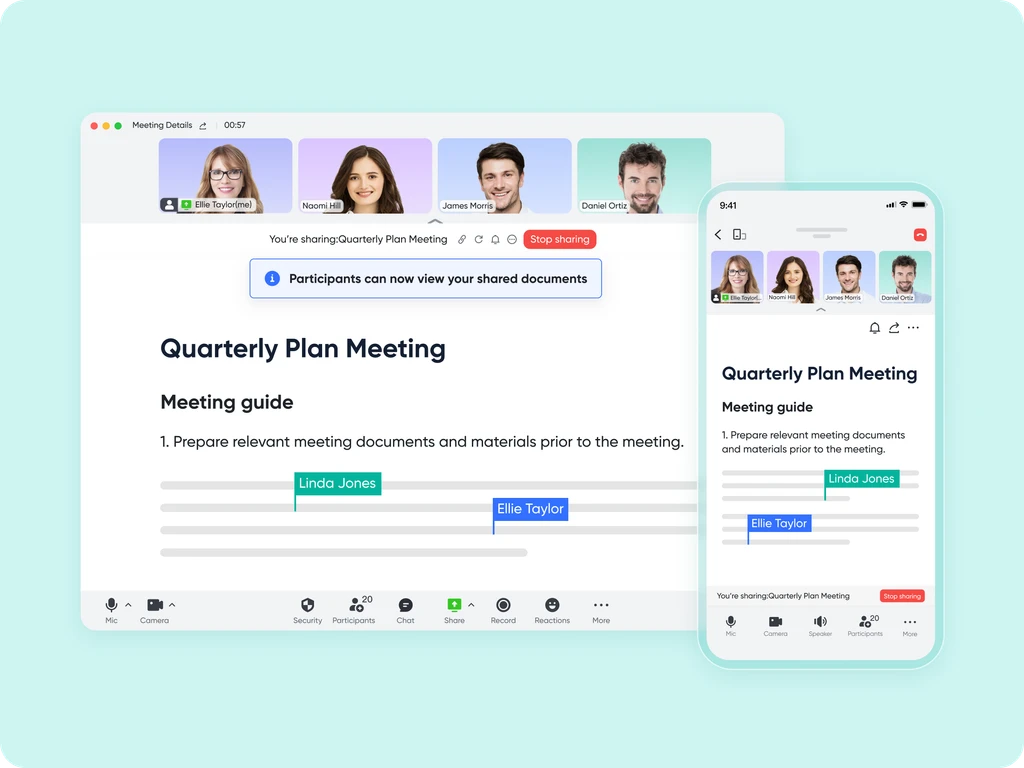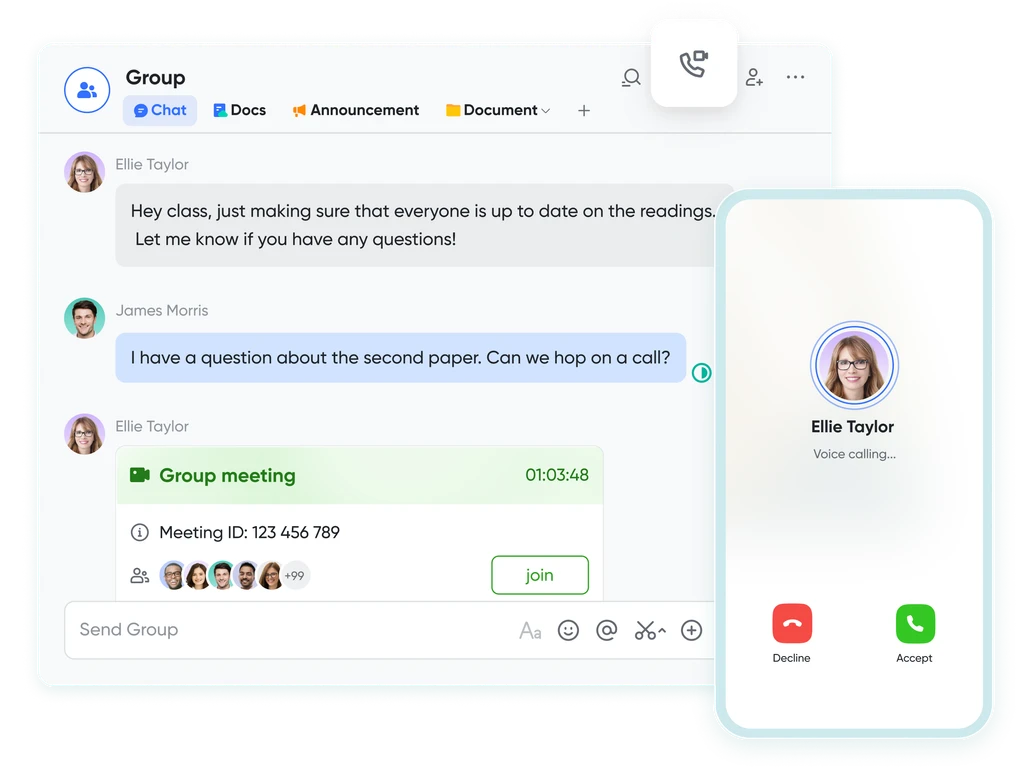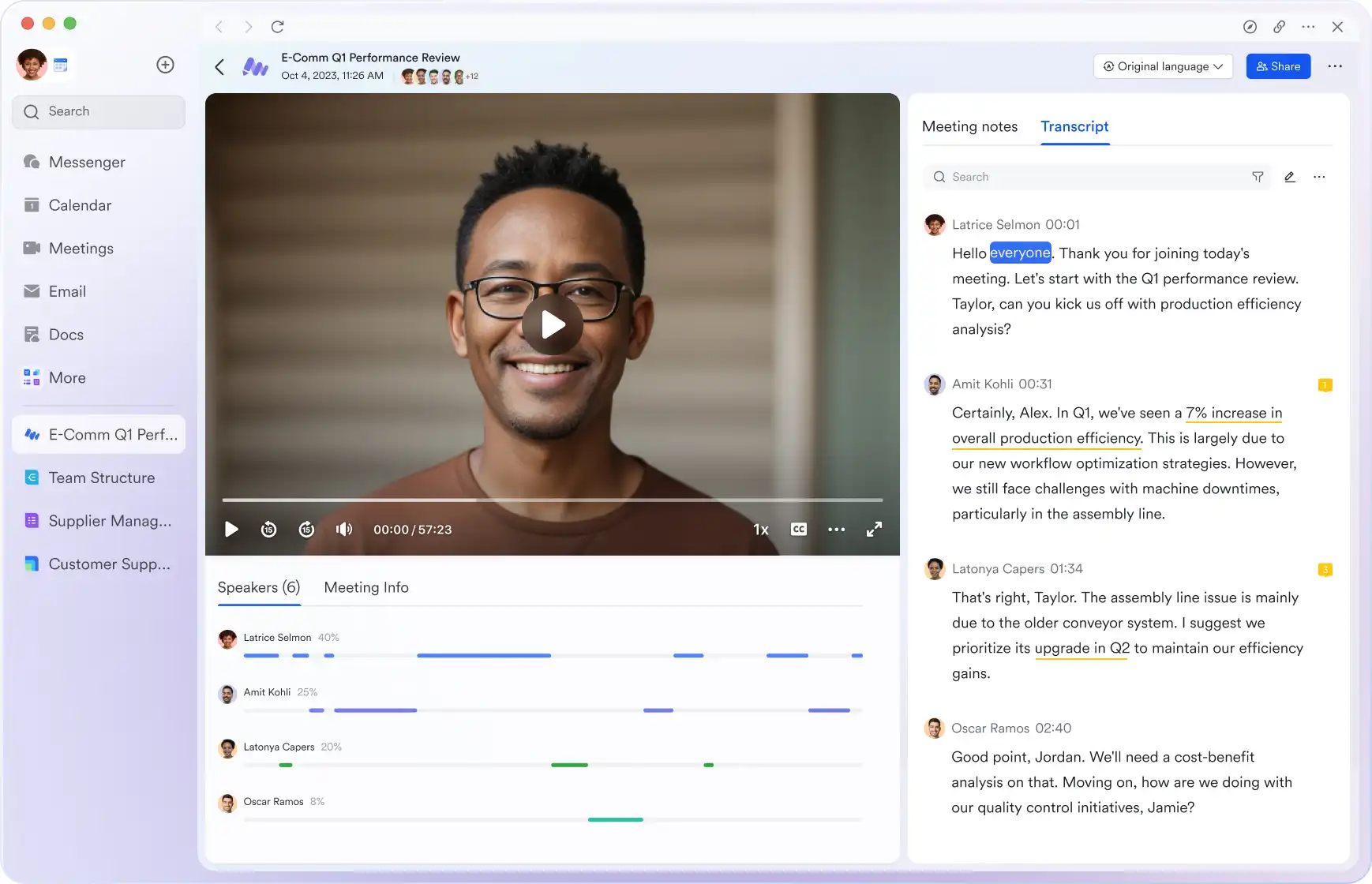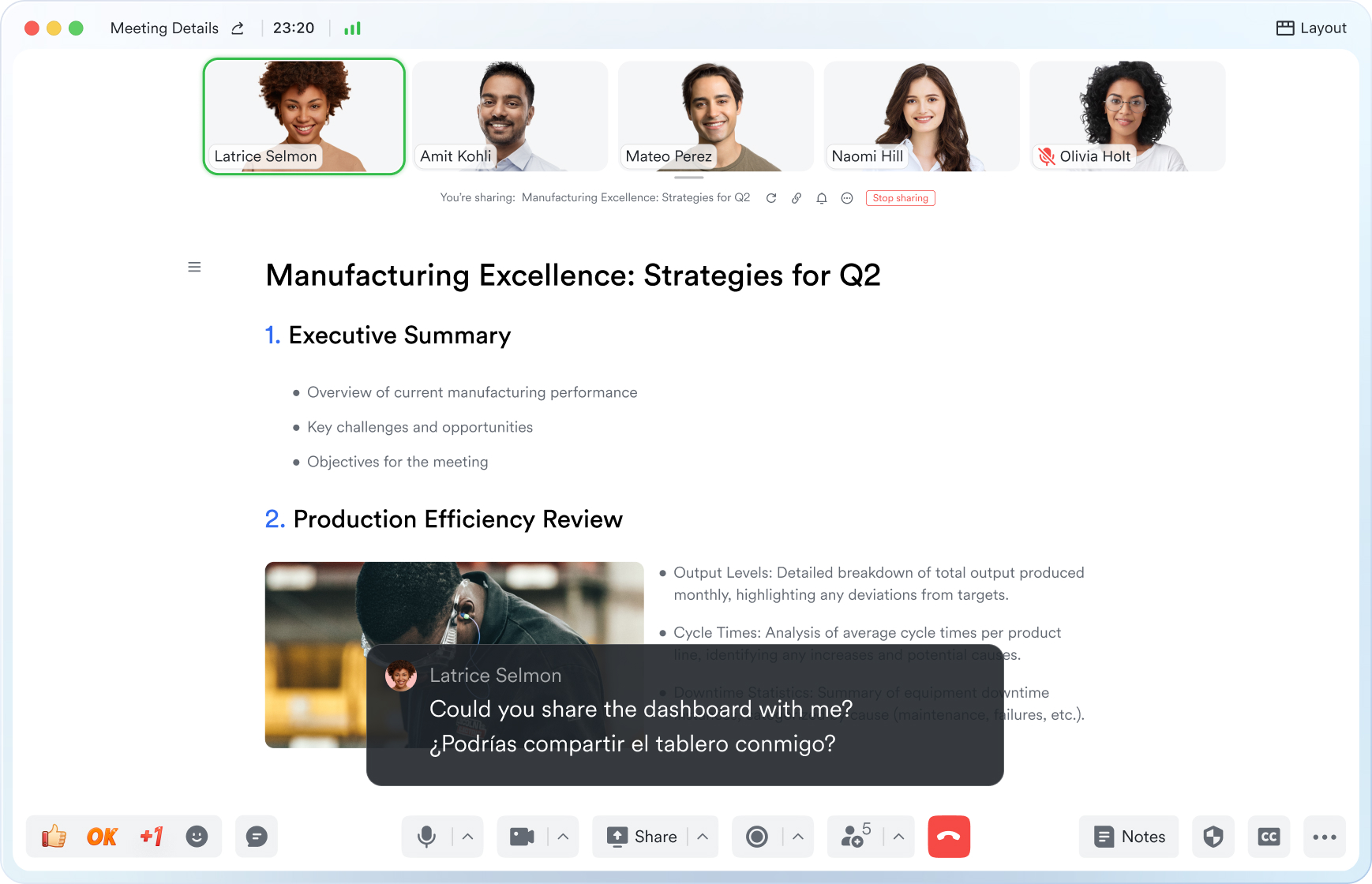Strategic Planning Meeting
This guide will walk you through the essential elements of use strategic planning meeting to keep your attendees aligned and engaged.
Try Lark for Free
In the contemporary business landscape, strategic planning meetings play a pivotal role in shaping the future trajectory of organizations. Successfully navigating through these sessions demands meticulous preparation, insightful deliberations, and actionable takeaways. This comprehensive guide aims to provide an in-depth understanding of the best practices for hosting a successful strategic planning meeting in 2024, catering to the evolving needs of businesses in a dynamic environment.
Use Lark Meetings to turn meetings into true collaborative experiences.
What is a strategic planning meeting?
A strategic planning meeting is a structured session where key stakeholders come together to envision, analyze, and plan the future direction and priorities of an organization. It serves as a platform for aligning business strategies with overarching goals, fostering synergy among decision-makers and ultimately driving sustainable growth. This meeting is not only about setting objectives but is also about identifying potential obstacles and outlining a clear path towards success.
Goals of a strategic planning meeting
The primary goals of a strategic planning meeting encompass setting a clear direction for the organization, identifying growth opportunities, analyzing market trends, and developing actionable strategies to achieve the company's long-term objectives. Additionally, these meetings aim to enhance collaboration, encourage innovative thinking, and ensure the effective allocation of resources for the attainment of shared goals.
Who should attend a strategic planning meeting?
Key stakeholders, including senior management, department heads, and individuals with a comprehensive understanding of the business landscape, should be part of a strategic planning meeting. It is crucial to involve individuals who can contribute diverse perspectives and possess decision-making authority, thus ensuring that all strategic decisions are well-informed and aligned with the overarching objectives of the organization. Furthermore, cross-functional participation is essential to capture comprehensive insights and perspectives that may impact the strategic direction of the organization.
Learn more about Lark x Meetings
Topics, agenda, and structure of a strategic planning meeting
The topics, agenda, and structure of a strategic planning meeting play a crucial role in its success. The agenda should be meticulously crafted to cover core elements such as SWOT analysis, market dynamics, competitive landscape, financial performance, and strategic initiatives. Additionally, the meeting structure should incorporate interactive discussions, workshops, and breakout sessions to encourage active participation and elicit valuable insights from the attendees.
Learn more about Lark x Meetings
How often does a strategic planning meeting occur?
The frequency of strategic planning meetings varies based on the organization's industry, size, and growth trajectory. While some organizations conduct these meetings annually, others may opt for more frequent sessions, such as bi-annual or quarterly meetings. The ideal frequency depends on the pace of change in the industry, the need for strategy refinement, and the organization's growth ambitions.
Key differences between strategic planning meetings and other similar meetings
Strategic planning meetings differ significantly from other types of business gatherings, such as operational or tactical meetings, in terms of focus, scope, and outcomes. Unlike operational meetings that primarily address day-to-day activities and short-term goals, strategic planning meetings center around long-term vision, market positioning, and transformative strategies that shape the organization's future.
Learn more about Lark x Meetings
Three practical examples of strategic planning meetings
Enhancing market competitiveness through strategic planning
Enhancing market competitiveness through strategic planning
In a competitive industry, a multinational corporation successfully leveraged a strategic planning meeting to realign its product portfolio and market positioning, resulting in a significant increase in market share and brand relevance.
Innovation-driven strategic planning in the technology sector
Innovation-driven strategic planning in the technology sector
A leading technology firm orchestrated a strategic planning meeting aimed at fostering a culture of innovation, resulting in the development of breakthrough solutions and a robust intellectual property portfolio, positioning the company as an industry pioneer.
Revitalizing organizational culture through strategic planning
Revitalizing organizational culture through strategic planning
In an organizational transformation initiative, a traditional company utilized a strategic planning meeting to redefine its core values, revamp its organizational culture, and enhance employee engagement, leading to a remarkable improvement in productivity and employee retention.
Common pitfalls of a strategic planning meeting
Strategic planning meetings may encounter challenges that impede their effectiveness. Common pitfalls include:
- Lack of Alignment: When stakeholders' perspectives and expectations are not aligned with the organization's long-term vision, it can lead to conflicting strategies and suboptimal decisions.
- Inadequate Preparation: Insufficient pre-meeting preparations, including incomplete data analysis or outdated information, may hinder productive discussions and decision-making.
- Poor Execution of Decisions: Even after productive discussions, the ineffective execution of decisions and strategies can diminish the impact of the meeting.
To overcome these pitfalls, it is imperative to adopt robust planning, inclusive participation, and clear communication throughout the strategic planning process.
Related:
Unlock the Power of Webinars: A Comprehensive Guide to Boost Your Business | Lark Blog | Lark BlogLearn more about Lark x Meetings
Dos and don’ts of a strategic planning meeting
| Dos | Don’ts |
|---|---|
| Encourage diverse participation | Disregard input from key stakeholders |
| Prioritize long-term strategic goals | Focus solely on short-term operational challenges |
| Facilitate open and constructive discussions | Allow dominating personalities to monopolize discussions |
| Align decisions with organizational vision | Succumb to personal biases and hidden agendas |
| Establish clear action items and follow-up mechanisms | Leave critical decisions unresolved or vague |
What makes a virtual strategic planning meeting successful?
Conducting successful virtual strategic planning meetings requires a thoughtful approach and leveraging digital tools for seamless collaboration. Key elements for success include:
- Utilizing Interactive Technologies: Incorporating interactive features and collaborative tools to engage participants and facilitate real-time interaction.
- Structured Virtual Breakout Sessions: Organizing virtual breakout sessions to encourage focused discussions among smaller groups, ensuring inclusivity and active participation.
- Cybersecurity and Data Privacy: Prioritizing robust cybersecurity measures to safeguard sensitive organizational information and ensure data privacy during virtual meetings.
Related:
Unlock the Power of Webinars: A Comprehensive Guide to Boost Your Business | Lark Blog | Lark BlogLearn more about Lark x Meetings
Typical takeaways of a strategic planning meeting
The outcomes of a strategic planning meeting should translate into actionable takeaways that drive organizational growth and success. Typical takeaways include:
- Defined Strategic Objectives: Clear articulation of long-term organizational goals, strategies, and action plans to achieve them.
- Identification of Key Initiatives: Prioritization of critical initiatives and projects aligned with the strategic vision and organizational priorities.
- Resource Allocation and Accountability: Clarity on resource allocation, accountability frameworks, and milestones to track progress and measure success.
Questions to ask in a strategic planning meeting
Effective questioning plays a pivotal role in extracting valuable insights and fostering productive discussions during a strategic planning meeting. Key questions include:
- What are our core competencies, and how can we leverage them to gain a competitive advantage?
- What emerging market trends and disruptive forces should we consider in our long-term strategy?
- How can we align our strategic initiatives with evolving customer preferences and market dynamics?
- What potential risks and challenges should we anticipate, and how can we proactively address them?
- How do our strategic decisions today contribute to our long-term sustainability and resilience in a rapidly changing business environment?
Learn more about Lark x Meetings
Conclusion
Convening a successful strategic planning meeting in 2024 necessitates a holistic approach encompassing meticulous planning, inclusive participation, and decisive action. By embracing the best practices and insights outlined in this guide, organizations can elevate their strategic planning endeavors, driving sustainable growth, market relevance, and long-term success.
F.a.q
What are the key attributes of a successful strategic planning meeting?
A successful strategic planning meeting is characterized by comprehensive preparation, active participation from key stakeholders, inclusive discussions that encompass diverse perspectives, and the formulation of clear, actionable strategies aligned with the company's vision and long-term objectives.
How can a company ensure active participation in a strategic planning meeting?
Active participation in a strategic planning meeting can be ensured through effective communication of the meeting's significance, creating opportunities for open dialogue and idea-sharing, and acknowledging and valuing the input of all participants regardless of their hierarchical position within the organization.
What are some effective virtual tools for conducting a virtual strategic planning meeting?
Virtual strategic planning meetings can be facilitated using collaborative platforms such as Zoom, Microsoft Teams, or Webex, virtual whiteboarding applications, and project management tools that enable real-time collaboration, idea generation, and documentation of meeting insights and decisions.
How can potential conflicts during strategic planning meetings be effectively managed?
Potential conflicts during strategic planning meetings can be effectively managed by establishing ground rules for respectful dialogue, acknowledging diverse perspectives, addressing disagreements constructively, and channeling conflicting viewpoints towards actionable resolutions that align with the overall strategic vision.
What are the long-term benefits of implementing the outcomes of a strategic planning meeting?
Implementing the outcomes of a strategic planning meeting leads to a compelling strategic roadmap, enhanced organizational alignment, prioritization and utilization of resources, and the identification and mitigation of potential pitfalls, thereby fostering sustainable growth, resilience, and competitiveness in the long run.
Use Lark Meetings to turn meetings into true collaborative experiences.
A Game Changer for Strategic Planning Meeting: Empower your team with Lark Meetings
In the fast-paced and dynamic world of modern business, effective communication and collaboration are crucial for success of Strategic Planning Meeting. Here we introduce Lark Meetings to serve as a centralized hub for all communication needs.
Transform your meetings into collaborative endeavors

Leverage the potency of in-call document sharing, intelligent meeting minutes, and mobile-optimized features to enhance productivity collaboratively, irrespective of your location or schedule.
Seamlessly collaborate in real-time, across any device

Share live documents instead of just screen views. Participants can navigate and edit simultaneously within the video call window, even while on the move.
Shift your focus to engagement, not note-taking

Lark Minutes automatically converts video meetings into transcripts, facilitating easy viewing, searching, and collaborative editing. Stay in the loop asynchronously, even if you can't attend the live meeting. Lark Minutes for meeting minutes support translation into 10+ different languages.
Break language barriers in communication

Lark Meetings provide real-time translation for subtitles, allowing individuals from diverse backgrounds to express themselves in their native languages. Ensure every voice is heard, regardless of geographical location. Live subtitles currently support translations from English, Chinese, and Japanese to 10+ different languages. See more translation feature in Lark.
Connect with larger audiences
Host dynamic online meetings and events accommodating up to 1,000 participants, with the flexibility of up to 50 breakout sessions for intimate group discussions within the larger meeting context. Try more Lark features for free.








